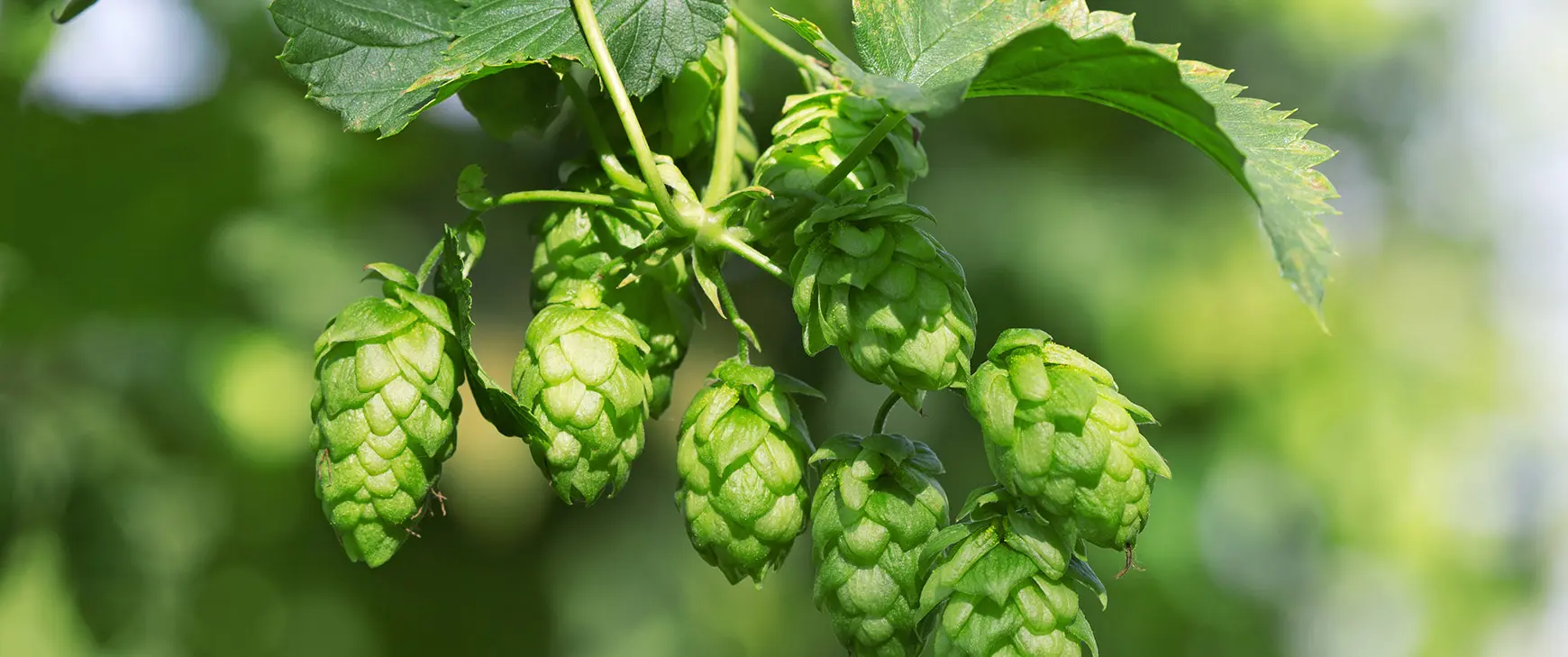
Hops (Humulus lupulus)
Hops are not only an indispensable ingredient in brewing beer. The hop cones or their derivatives are traditionally used to improve mild symptoms of stress and as a sleep aid. The combination of hop cones and valerian root is medically recognised for sleep disorders.
The true hop (Humulus lupulus L.) is known to many people as an ingredient in beer. Beer does indeed have a sleep-inducing effect, but this is mainly due to its alcohol content. Alcohol sometimes makes it easier to fall asleep, but it prevents restful sleep at night because the natural sleep pattern is disturbed. Hops, on the other hand, are a sleep aid when taken in the right preparation and are often used in a combination of hops and valerian. Read more about hops, the cultural history of the plant and its use as a medicinal plant against sleep disorders in this article.
Occurrence and distribution of hops
There is a total of three hop species from the genus Humulus. They belong to the hemp family (Cannabaceae). While the other two species are rare and only occur in certain parts of Asia, the true hop (Humulus lupulus L.) is widespread throughout Central Europe. Wild hops often grow in nitrogen-rich locations in lowland forests, on the edges of forests and near bodies of water.
Often, however, hops are not found in their wild form, but as cultivated hops. Cultivated varieties of hops are grown in large quantities. Around 95 per cent of the harvest is needed for beer production. The rest of the harvested cones are used for medicines that promote sleep and facilitate falling asleep. The leading countries involved in hop cultivation are the USA, Germany and the Czech Republic. In Switzerland, hops are only grown on a small scale with the result that only around ten percent of the country's requirements can be met by Swiss-grown hops.
Appearance of hops
Hops are a perennial climbing plant. The leaves are three-lobed and toothed around the edges. Since the plant twists clockwise around climbing aids, it is also called a right twister. Some cultivated varieties can grow up to ten metres tall. Hops are typically cultivated on high frames in what are often called hop gardens.
Hops are a dioecious plant. This means that there are purely female and purely male plants. Only the female plants are cultivated. These form the hop cones which are used medicinally and for making beer. From the end of August, the cones can be harvested and then gently dried.
History and tradition of hops
The first purity laws for beer already existed in the Middle Ages. They state that the beer must only consist of hops, malt and water. Hop cones were used both for their aromatic-bitter taste and for their preservative effect. Hildegard von Bingen said as long ago as 1153 that the bitterness of hops prevents rot ("putredines prohibet in amaritudine sua"). Hop cones have also been traditionally used as a herbal sleep aid for a very long time.
However, wild hops were also used for many other purposes. In libraries, sacks with hop cones served as protection against moisture. Their essential oil content also protected the books from pest infestation. Wild hops were also used as an edible plant. Today, what is called "hop asparagus" is gaining in importance again and is available in some regions in March or April. These are the young, freshly sprouted shoots of the plant.
Ingredients and effect of hops
The hop cones, which have countless glandular hairs on the inside, produce a resinous substance that consists largely of so-called “hop bitters” such as humulone and lupulone. During storage of the hop cones, the volatile substance 2-methyl-3-buten-2-ol separates from the bitter substances. Pharmacological studies demonstrate the sedative, antispasmodic and sleep-inducing properties of this active ingredient. Other components of hop essential oil such as myrcene, humulene and caryophyllene probably also contribute to the calming effect.
Laboratory tests have shown that components of hop extract bind with melatonin receptors. Further research is investigating which ingredients are responsible for this phenomenon. Melatonin is also known as the sleep hormone and controls our sleep-waking time rhythm. Therefore this could be the reason why hops help us fall asleep.
Hops as a medicinal product
Hops (often in combination with valerian) are mainly used as a herbal sleep aid to combat difficulties in falling asleep. But preparations made from hop cones can also help with stress and nervous complaints.
Hops as a sleep aid
Scientific studies suggest that active ingredients in the plant help people fall asleep. This ancient medicinal plant is therefore particularly appreciated nowadays as more and more people have trouble falling asleep. With the help of some tips, healthy sleep can be promoted even without sleeping pills, for example by improving sleep hygiene. People who cannot sleep well or are unable to fall asleep are often helped by the use of herbal remedies containing, for example, hops.
Hops and valerian against sleep disorders
Hops and valerian complement each other in their effect on sleep. The combination of the two plants can reduce the time it takes to fall asleep and also improve other sleep parameters. Many synthetic sleeping pills can lead to dependence or to tiredness and fatigue (a hangover effect) the following morning if taken over a long period of time. Such dependencies are unknown for medicines with valerian and hops.
Hop preparations to alleviate mild stress symptoms
Traditionally, hops are also used for restlessness and stress-related mood disorders. Hops extract can often have a supportive effect when used as an additive in medicines against complaints caused by nervousness.
This is general information. For individual advice, please contact a specialist.
Modern herbal medicine
Modern herbal medicine (phytotherapy) combines centuries-old knowledge with the latest scientific findings.
DetailsModern herbal medicine
Modern herbal medicine (phytotherapy) combines centuries-old knowledge with the latest scientific findings.
Details
